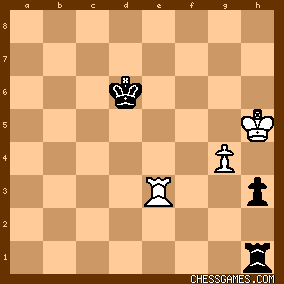| Dec-14-15 | | patzer2: According to the 6-piece endgame table base at http://www.shredderchess.com/online..., Black missed a table base draw after 51. Kh5 (diagram below)
click for larger viewwith the decisive error 51...Rf1? which loses in 40 moves. Instead, 51...h2, 51...Ra1, 51...Rb1 and 51...Rc1 all lead to a draw. Deep Fritz 14 at 26 depth, without the benefit of an endgame table base, evaluates 51...h2 (draw) and 51...Rf1? (losing in 40 moves) the exact same slight but unclear advantage for White (+1.45 @ 26 depth). So if a strong computer program like Deep Fritz 14 can't clearly assess it, it's understandable how a strong human player (even a Super GM) can miss it in the time pressure of a rapid game. |
|
| Dec-14-15 | | Eyal: Objectively - or from a "tablebase viewpoint" - 51...Rf1? was indeed the decisive mistake. But from a practical viewpoint, I'd say 56...Ra6 was a serious mistake as well - once the white rook takes over the f-file, the win (by achieving a Lucena-type position) becomes quite elementary. Instead, leaving the black rook on the f-file would have posed more problems for White, who has to be very accurate. For example: 56...Rf7 57.Rh8 Rg7+ 58.Kh5 Kf6 (58...Kf7 59.g5 Rg6 60.Rf8+! Kxf8 61.Kxg6 with a winning pawn endgame) 59.Rf8+ Ke7 60.Rf3  . Or 56...Rf1 57.Rh7+ Kf8 58.Kg6 Kg8 59.Rg7+! Kh8 (59...Kf8 60.Ra7 followed by Ra8+, g5, Kg7 and so on) 60.Rf7! . Or 56...Rf1 57.Rh7+ Kf8 58.Kg6 Kg8 59.Rg7+! Kh8 (59...Kf8 60.Ra7 followed by Ra8+, g5, Kg7 and so on) 60.Rf7! It might be mentioned in this context that Lars Bo Hansen (who obviously didn't bother checking with a tablebase...), in his "Game of the Day" video for ICC, claims that the position after 56...Rf1 is an "elementary draw", giving a line beginning with 57.Rh7+ Kf8 58.Kg6 Kg8 59.g5 (instead of Rg7+!). |
|
| Dec-14-15 | | patzer2: <Eyal> Thanks for the endgame lesson. The shredder 6-piece endgame table base gives 56...Rf7 as losing to mate-in-37 while 56...Ra6 loses to mate-in-32. The "elementary draw" 56...Rf1 loses to mate-in-36. |
|
| Dec-14-15 | | Mehem: <patzer2:it's understandable how a strong human player (even a Super GM) can miss it in the time pressure of a rapid game.> Not quite understandable. Super GM should have all the basic rook endings at his fingertips. |
|
Dec-14-15
 | | chancho: Some comments from La Regleu De Jeu:
<Korsatsky: Respect to Magnus Carlsen: being the world champion and playing so often is not that trivial in chess. I remember Vishy Anand playing just a couple of games before the World Ch, being concerned; about revealing his prep openings; and therefore playing secure draws; Magnus is a different story, a truly extraordinary talent! beerpatzer_: Mangus Carlsons is actually a robot invented in the 22nd century but trasnported back in time by a rich slime called Brrrghhh in 2101.> http://laregledujeu.org/arrabal/201... |
|
| Dec-14-15 | | Eyal: < Not quite understandable. Super GM should have all the basic rook endings at his fingertips.> That’s true about the position after 56…Ra6(?) 57.Rf3 – here it’s quite clear and straightforward how White is going to get a Lucena position, which is indeed why MVL resigned. But I wouldn’t call the position after 51.Kh5 (of which <patzer2> was speaking) "a basic rook ending" in this sense, even though there are only six pieces left over the board. As I mentioned above, at least one of the winning lines for White after 56…Rf1 contains an almost study-like idea (with 59.Rg7+/60.Rf7). There’s actually some concrete evidence about the "Super Gm" viewpoint here – Grischuk was doing live commentary during the game together with Chris Ward & Nigel Davies, and until 56…Ra6 was played he thought it should be a draw. When someone from the audience mentioned a little earlier (apparently based on a computer or a tablebase) that it’s winning for White he was surprised – he can be heard saying "Why Ra6, why not Rf1? How White wins after Rf1?"
(http://livestream.com/chess24/event..., from about 46:30; Grischuk actually figures out a bit later how White is winning after 56…Rf1, but it takes him a couple of minutes and then he already <knows> there has to be a win). |
|
| Dec-14-15 | | morfishine: "Late Mistakes"
No one in the history of recorded chess has been able to explain "Late Mistakes" ***** |
|
| Dec-14-15 | | waustad: I suspect that accuracy goes down after playing for around 9 hours. |
|
| Dec-16-15 | | latvalatvian: Stay away from those evil chess computers. Use your own brains! |
|
| Dec-19-15 | | Ulhumbrus: GM Kavalek has included some instructive comments on this ending in an article. Here is a link to the page: http://en.chessbase.com/post/huffin... |
|
| Jan-10-16 | | child8: Against the world champion--though he was in time trouble--the board position suggested as most sound the clearcut 45....g4! Vachier spent ~80 secs of his 12 minutes remaining to play the highly gambling 45....h4, hence his own troubles mounted rapidly. Naturally Carlsen replied in a second with 45. g4. Youtube.com has a video of this game and the time unfolding. |
|
| Jan-11-16 | | child8: 45...g4 appears to lose to 46. Kd5 h4, 47. gh4 Rh3, 48. Re7+ Kf8, 49. Re4 Rd3, 50. Rd4 Rg3, 51. h5 Ke8, 52. Re4 Kd7, etc.--a computer program assembled that. |
|
| Jan-11-16 | | Atking: <waustad: I suspect that accuracy goes down after playing for around 9 hours.> If there is something to say about MVL collapse at the end of the wonderful Tournament he realized, this is the most lucid comment. |
|
| Jan-13-16 | | child8: If 45....Rd2+, 46. Ke5 g4, 47. Rb3 Ke8, 48. Rb8+ Kd7, 49. Rb7+ Kd8, 50. Rh7 Rd3, 51. Rh5 Rg3=. |
|





